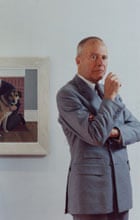 |
| Artist and Car, 2008 Alex Colville |
Alex Colville obituary
Canadian artist whose experiences at Belsen cast a dark shadow over a lifetime's work
Michael McNay
1 August 2013
Alex Colville, who has died aged 92, took a degree in fine art in 1942, enlisted in the Canadian infantry, married the poet and painter Rhoda Wright, and in 1944 was deployed as a war artist. The following year, after the British had overrun Bergen-Belsen in north-western Germany, Colville went with the Canadian 3rd division into the concentration camp where 10,000 bodies lay in an open grave. He sat down and sketched the scene. This dark experience yielded a macabre and awful image for the Canadian war museum in Ottawa and marked his art at a deeper level for the rest of his life.
The most obvious touchstone for Colville's mature work is the American realist Edward Hopper, who was almost 40 years older. The undertones of alienation and psychic disturbance in Hopper's work take on an even darker shade in Colville's paintings, which at first glance are more often than not innocuous-seeming scenes of Canadian middle-class life.
Take one instance: Child and Dog (1952), a placid scene of a small naked girl standing no taller than the black dog beside her. Is the animal to be trusted? The child thinks so. Or another, Horse and Train (1954), intended as more overtly frightening: a black horse careers along a railway track towards a trans-continental train steaming towards it. It was inspired by two lines from the South African poet Roy Campbell: "Against a regiment I oppose a brain/and a dark horse against an armoured train." Colville explained that the painting represents the eternal opposition of creation and destruction.
This is the literary approach to painterly values that was inevitably scorned during the high tide of modernism. Reviewing an exhibition of Canadian art at the Tate Gallery, London, in the Burlington Magazine in 1964, Keith Roberts, after praising Colville's prodigious skill, made a more telling point: "The enigmatic flavour of these paintings is, I suspect, superficial and technical rather than inherent and visionary."That is a difficult case to prove, and difficult to rebut. It could simply be said that some paintings succeed and some, equally fine technically, fail, and that this is rooted in the influences Colville chose: his other major experience of 1945 bearing on his painting was the ancient Egyptian art he saw in the Louvre, and in 1959 he visited Chicago to make a special study of the post-impressionist George Seurat's monument to stillness, La Grande Jatte. Colville chose to work with egg tempera, the medium of the pre and early Renaissance artists, and it is a medium that represents stasis superbly – think Piero della Francesca and Masaccio.
So the ambiguity of Colville's girl and dog, both in stasis, is that the situation might change in a trice. The horse and train are static, too: but although they are evidently intended to suggest momentum, they lack the suggestive fluidity of, say, Turner's Rain, Steam and Speed. Menace and the drawing in of night is suggested only by incidentals, such as the railway engine's glaring cyclopean headlight.
Colville was born in Toronto, the son of a Scottish emigrant father and Canadian mother, who moved to sea-girt Nova Scotia in 1929. Alex and Rhoda lived in Sackville, New Brunswick, from 1946 until 1973, when they moved to the house in Wolfville, Nova Scotia, where she had been born. So much of the work has a local maritime setting, from the faintly sinister panel of a man stripped to the waist, languidly leaning against a doorpost staring out to sea with a revolver lying on the table (Pacific, 1967), to the woman in a phone booth on a jetty as a cargo boat sails by (Departure, 1962), and a family piling into their car at the beach as the weather breaks up (Family and Rainstorm, 1955).
 |
| Pacific, 1967 Alex Colville |
He had studied for his degree at Mount Allison University, New Brunswick, and returned to teach there from 1946. With growing success in Canada and in New York, he felt secure enough in 1963 to earn a living solely from painting. He represented Canada at the 1966 Venice biennale and honours poured in: honorary degrees, membership of the privy council of Canada and being named in 1982 as a Companion of the Order of Canada. His work was exhibited at the Marlborough Gallery in London, and in Hong Kong, Beijing, Tokyo, Paris (where the Pompidou Centre has a Colville painting in its collection) and Cologne (where the Ludwig museum has acquired his work). Rhoda was a frequent nude model for her husband's paintings, causing mild scandal in the polite society of Wolfville, but like Pierre Bonnard's bathtub wife, stuck at it through to old age. She died last December after 70 years of marriage and a few months after the death of one of their sons, John. Colville is survived by their daughter, Ann, and two further sons, Graham and Charles.
• David Alexander Colville, artist, born 24 August 1920; died 16 July 2013
• This article was amended on 30 August 2013. The model for the painting Child and Dog was a girl rather than a boy, and the dog was not a full labrador. Alex Colville's mother was not a Scottish emigrant. He and his wife Rhoda, a painter as well as a poet, lived in Sackville, New Brunswick, from 1946 until 1973. He was already in the army at the time of his marriage. These points have been inserted or corrected.



No comments:
Post a Comment